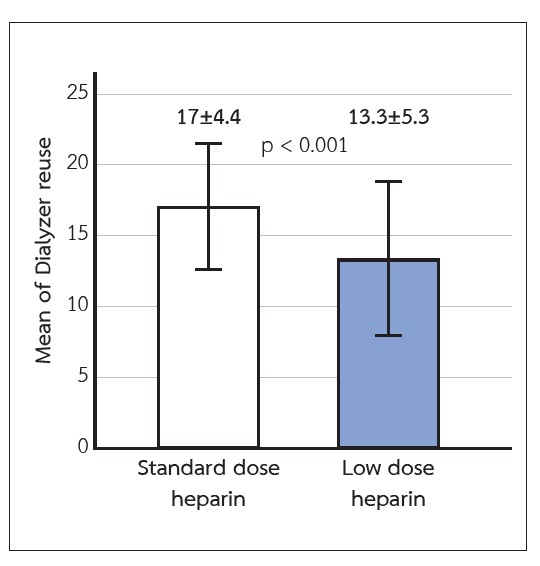Effect of Low-dose Heparin Anticoagulation on Number of Dialyzer Reuse in Maintenance Hemodialysis: A Randomized Crossover Study
Main Article Content
Abstract
Background: Heparin is commonly used to prevent clotting of dialyzer in maintenance hemodialysis. Higher dose of unfractionated heparin may increase the risk of bleeding, whereas lower dose may increase the risk of clotting and limit the number of dialyzer reuse. The present randomized crossover study compared the efficacy and safety of low-dose heparin anticoagulation with standard-dose heparin anticoagulation in maintenance hemodialysis.
Method: Seventy five stable maintenance hemodialysis patients underwent 1:1 randomization to receive low-dose heparin anticoagulation protocol (LDP) (loading 15 units/kg and maintenance 500 units/hour) or standard-dose heparin anticoagulation protocol (SDP) (loading 50 units/kg and maintenance dose 1,000 units/hour). Primary outcome was the difference in the number of dialyzer reuse. Secondary outcomes were differences in activated partial thromboplastin time (aPTT), Kt/V, erythropoietin and iron requirements, iron parameters and adverse events.
Results: The number of dialyzer reuse was significantly lower in the LDP group compared with the SDP group (17±4 vs. 13±5 treatments, p<0.001). LDP group had lower aPTT values at 2 hours (36±13 vs. 70±36 seconds, p<0.001) and 4 hours (31±10 vs. 55±30 seconds, p<0.001) after dialysis initiation and Kt/V (1.7±0.4 vs. 1.9±0.4, p=0.001) compared with SDP group. Hemoglobin was higher in the LDP group. There were no differences in erythropoietin and iron requirements and iron parameters. Two minor bleeding at the vascular access site occurred in the SDP group. Other minor adverse events were not different between the two groups.
Conclusion: Using low-dose heparin anticoagulation resulted in a lower number of dialyzer reuse compared with standard-dose heparin. The negative impact on dialysis adequacy was also evident. Thus, low-dose heparin anticoagulation should not be recommended in the prevention of dialyzer clotting in maintenance hemodialysis patients with low risk of bleeding.
Article Details

This work is licensed under a Creative Commons Attribution-NonCommercial-NoDerivatives 4.0 International License.
This article is published under CC BY-NC-ND 4.0 license, which allows for non-commercial reuse of the published paper as long as the published paper is fully attributed. Anyone can share (copy and redistribute) the material in any medium or format without having to ask permission from the author or the Nephrology Society of Thailand.
References
Shen JI, Winkelmayer WC. Use and safety of unfractionated heparin for anticoagulation during maintenance hemodialysis. Am J Kidney Dis. 2012;60:473–86.
Murea M, Russell GB, Daeihagh P, Saran AM, Pandya K, Cabrera M, et al. Efficacy and safety of low-dose heparin in hemodialysis. Hemodial Int. 2018;22(1):74–81.
Swartz RD, Port FK. Preventing hemorrhage in high-risk hemodialysis: regional versus lowdose heparin. Kidney Int. 1979;16(4):513–18.
Chanard J, Lavaud S, Maheut H, Kazes I, Vitry F, Rieu P. The clinical evaluation of low-dose heparin in haemodialysis: a prospective study using the heparin-coated AN69 ST membrane. Nephrol Dial Transplant. 2008;23:2003–9.
Chairat Shayakul, editor. Hemodialysis Clinical Practice Recommendation 2014. Bangkok (Thailand): October Press Publishing: 2014.
Claudel SE, Miles LA, Murea M. Anticoagulation in hemodialysis: A narrative review. Semin Dial. 2020;34:103-15.
Daugirdas JT, Blake PG, Ing TS, editors. Handbook of dialysis. 5th ed. Philadelphia: Wolters Kluwer; 2015.


